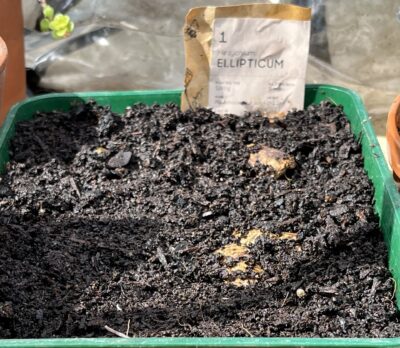Sow celeriac, spinach and turnip in modules early in the month. Use peat free seed or finely sieved multipurpose compost; larger seeds like peas and beans can be sown in straight multipurpose compost.

Sow half-hardy annuals including climbers for ornamental outdoor displays. Like all greenhouse grown plants, they need ‘hardening off’ ready for transplanting once the danger of frost has passed and the soil has warmed. If you are sowing the climber ‘Morning Glory’, soak the seeds in tepid water for 24 hours then sow at 20C in small pots or modules, to avoid root disturbance when transplanting, then grow on in cooler conditions and ‘harden off’ when temperatures increase. They are very cold sensitive, and show their disapproval with pale yellow or white leaves, growth is checked and sometimes they do not even recover. If you only need a few, save sowing spacy and buy plug plants then grow them on in the greenhouse.
Ensure the greenhouse is well-ventilated on warm days but avoid draughts, use louvres or vents on the leeward side rather than opening the door, if the wind is chilly. Cover tender plants with fleece at night if the greenhouse is unheated; shade seedlings with newspaper or fleece on the day, to prevent scorching.
Prick out Peppers and Aubergines into modules or individual post once the seed leaves have expanded holding them by the leaves, not stems.
Plant tomatoes, chillies and aubergines in growing bags. Turn the bags end over end, several times to mix the compost then make slits in the base for drainage tomatoes need at least 10 litres of compost per plant to keep the rootball moist, for maximum production and to reduce the chances of ‘Blossom End Rot’ and cucumbers need 15 litres. Depending on the size of the Growing bag, it can be better to plump them up like a pillow, turn in one end and only put two plants in each bag, rather than three to provide extra rooting space. Cut out planting holes, soak the compost with tepid water and allow to it drain before planting.
Damp down or mist citrus plants regularly when flowering begins using tepid water and change to summer fertiliser. Maintain a min temperature of 14°C (57°F) to maintain good growth. Pick forced strawberries under heated glass and protect them from hungry squirrels if the greenhouse door is temporarily open.
Look out for early red spider mite and aphids on strawberries as it is easier to control smaller populations. Use environmentally friendly insecticides like soft soap or plant growth stimulant, as they leave no lasting residue so you can easily change to biological controls later in the summer as they leave no lasting residue.
Pot up tomato seedlings when they develop true leaves above the more rounded seed leaves, if they have become a little ‘leggy’ then remove the lower leaves and plant them deeply. New roots will then grow from the stems and the size of the root system increases. You can also remove the lower leaves from perfect tomatoes and plant them deeply.
Happy Gardening! Matt


